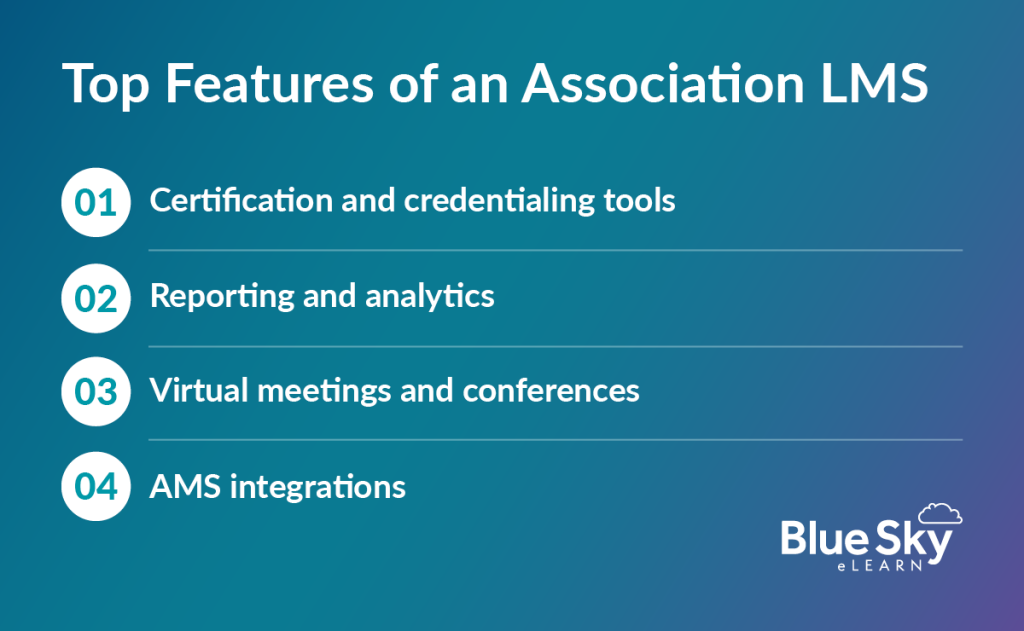
Every association offers its members a unique range of benefits, from specialized skill training to coveted networking opportunities. As such, every association also needs its own set of software to facilitate its programming and day-to-day operations.
From LMSs to CRMs, there are a number of tools that can catapult your association’s offerings and operational capabilities forward. However, with rapid technological advances, identifying which tools are actually necessary for your organization can be difficult in an oversaturated market.
To help cut through the confusion, this guide will explore five software platforms most beneficial to associations.
Association Management Software
Association management software (AMS) is the core platform associations use to manage internal operations. While various AMS solutions focus on different aspects of association management, most software will arm your organization with the following features:
- Member management. Create an improved member experience by creating membership tiers and leveraging a database that tracks member data, renewals, and payment information.
- Communication tools. Get in touch with members to promote new activities, remind them of upcoming renewal deadlines, request feedback on your offerings, and more with communication tools.
- Financial management. Dues collection is essential for maintaining revenue, and your AMS should allow you to handle member payments, track receipts, and generally keep your finances organized.
- Reporting and analytics. Assess your association by using your AMS to collect and store data related to member satisfaction. Many AMSs come with pre-set report templates to help you find key information, such as membership retention, growth, and engagement rates.
Additionally, many AMSs offer tools for managing events, engaging with members, and organizing content. The extent to which these features are built out depends on the vendor, and many associations looking for more robust software may opt for separate platforms for their events, member engagement, and course management.
Learning Management System
Professional and trade associations often provide educational offerings to help members improve their skills and advance their careers. To deliver this content, associations should invest in a learning management system (LMS).
Blue Sky eLearn’s guide to association LMSs goes over the top features to look for in this type of software:

- Certification and credentialing tools. As members complete your courses, an LMS can track their progress and automatically award them with the proper certification upon a course’s completion.
- Reporting and analytics. Understanding how members engage with your educational offerings allows you to improve your courses. Generate reports to discover metrics such as learner progress, course completion rates, engagement levels, and more.
- Virtual meetings and conferences. Provide members with valuable learning opportunities via courses taught by live experts through virtual meeting software. Lecturers can present to members in an interactive setting.
- AMS integrations. Ensure your LMS connects with your AMS. This allows all data collected through your LMS to flow smoothly into the member profiles stored in your AMS, allowing you to better connect with your members.
In addition to these features, also consider if an LMS fits your industry needs. There are many specialized LMSs for specific fields, such as law, healthcare, and education. With a specialized tool, you can present higher-quality courses to professionals in your sector.
Community Management Platform
Tradewing’s guide to community management platforms describes these tools as software that allows associations to create online spaces where members can interact. According to the guide, “these platforms create social media-like interfaces where members can post content, message one another, attend virtual events, and more, depending on the specific platform’s features.”
Essentially, a community management platform provides your members with a space to interact with one another online. Many associations only offer a handful of in-person events every year, and a community management platform allows members to connect between these meet-ups.
These tools keep your community active and vibrant by allowing for continuous socialization. Additionally, they provide a space for user-generated content to thrive. Members can share content they’ve created themselves or have found elsewhere and think would interest the rest of your association. This helps maintain high levels of engagement, even during lulls in your association’s programming.
Event Management Software
Events are a core part of many associations’ offerings. While simple, free event tools may help facilitate short online meetings, associations looking to host in-person events or offer a professional, engaging online experience should invest in event management software.
When it comes to event management, look for a platform that provides:
- Sophisticated online conferencing tools
- Event scheduling and flexible calendars
- Ticketing and registration
To maintain consistent data, your event management tools should integrate with the rest of your software, particularly AMS and community management software. For instance, you might promote an online event to your members through your community management software. Then, you can host said event on that platform to keep member attention focused.
Customer Relationship Management Software
An AMS and customer relationship management (CRM) software have quite a bit in common, as both tools help associations manage their members. However, the key difference between the two is that an AMS supports a range of functions associations need to operate on a day-to-day basis, while a CRM is solely focused on member data and engagement.
For example, you might note member join date in your CRM and use this information to send a tailored message cadence to welcome new members. Or, you might track what type of content a member regularly engages with so you can promote similar offerings directly to them in the future.
Your CRM should allow you to customize member profiles to your needed specifications. For instance, a few entry fields you might track include:
- Name
- Contact information and preferences
- Employer name
- Job title
- Alma mater
- Professional interests
- Member join date
- Engagement history
With this information, you can better tailor your offerings to align with members’ interests. For example, you might launch a multichannel marketing strategy and take note of which platforms members use to respond to your messages. Then, for future marketing campaigns, you could craft personalized messages and send them through their preferred communication channel.
Your software powers your association, and the right tools ensure you can provide your members with the benefits they need. To improve your software, assess your association’s tech stack to determine if your current tools are meeting your needs and what could be improved.